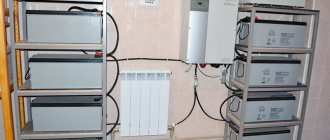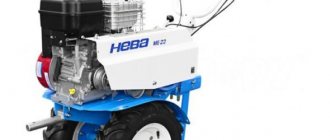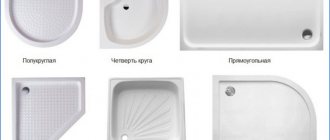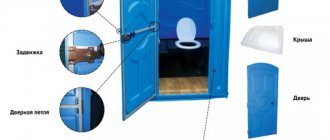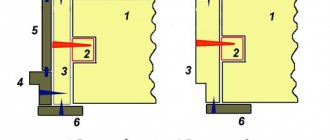It’s hard to imagine a modern major renovation of an apartment or private house without the use of a wall chaser. After all, without this tool it is impossible to cope with such a difficult task as laying wiring and pipes. Fortunately, the modern market is filled with a variety of models, and among them there are both expensive and very budget options. True, choosing a quality wall chaser is still not always easy. If only because even an experienced user, not to mention a beginner, can get lost in the numerous characteristics. It is for this case that our experts have compiled the TOP of the most successful models. Since the rating includes the best wall chasers based on customer reviews and independent expert assessments, it is truly objective and will certainly help readers choose the most suitable tool.
Types of wall chasers
A wall chaser is a highly specialized tool designed for cutting grooves in wall materials (from gypsum and foam concrete to reinforced concrete).
Manual
This tool is driven solely by muscular force, which explains the limited scope of its application, namely: small volumes of work and soft surfaces. The principle of operation is similar to the operation of a hand plane on a wooden surface.
Manual wall chasers do not create a lot of noise and dust, but require relatively greater physical effort and also have low productivity. The size of the groove is strictly determined by the size of the equipment blade.
Electrical
Electric wall chasers are a more numerous type of equipment. They use electric motors of varying power.
According to the rated engine power, the tools are:
- low-power household - 0.9-1.3 kW;
- average -1.2-3 kW;
- professional – from 2 kW and above,
This gradation determines the scope of their application.
Wall chasers of various brands weigh from 3 to 11 kg. Specific models may differ in speed, cutting blade diameter, cut dimensions and the following additional options:
- device for connecting a vacuum cleaner;
- protection against overheating and unauthorized activation;
- speed maintenance system;
- soft start system.
Electric wall chasers are more productive and versatile; the groove parameters are regulated by selecting the diameter of the disk, as well as the distance between the cutters. Most often, diamond discs with a diameter of 125 and 150 mm are used, less often 230 and 300 mm.
Design features
The first thing you need to decide is how many cutting discs the wall chaser should be designed for. If you are only engaged in gating walls for wiring and laying pipes, it is enough to choose a tool with 2 disks, which allows you to make an even groove. A furrower with one disc allows you not only to groove walls, but also to do cutting work (cutting stone, metal and concrete).
Please note an important point - removing the second disc in order to cut stone or concrete is not allowed, so you will not be able to “kill two birds with one stone.”
Which wall chaser to choose.
The first thing you should consider when purchasing this specific tool is the type of power drive. There are both electric and gasoline models on the domestic market.
To be fair, it is worth noting that to create grooves in building materials with low density, manual wall chasers are also widely used, which are even driven by the operator’s muscular force. But we won’t talk about them today.
When choosing a wall chaser, you should decide on the expected frequency of use of the tool.
For example, for short-term work around the house, a tool with minimal performance from the budget price segment is suitable.
To solve professional problems in the construction industry, more powerful models are needed that can work without stopping for a long period of time.
When choosing a wall chaser, you should not forget about the technical characteristics of the tool, among which the most significant are:
1. Engine power. According to this parameter, all models can be divided into three classes:
- light (0.9-1.5 kW);
- medium (1.5-2.4 kW);
- heavy (more than 2.4 kW).
2. Tooling diameter – varies from 110 to 355 mm. This parameter affects the depth of the groove.
The rotation speed of the discs determines the performance of the tool. Depending on its class, it can range from 5 to 10 thousand rpm.
3. Groove width . It all depends on the user's needs:
- For laying single cables, a tool with a groove width of 20 mm is suitable.
- To install the pipeline, you need a furrow maker capable of making a groove 40-60 mm wide.
- Powerful wall chasers used on construction sites are capable of cutting a furrow up to 100 mm wide in one pass.
Don’t forget about the functional content of the tool:
- The speed control system will keep performance at a high level regardless of the load.
- Overload protection will allow you to avoid failure of an expensive tool, and the slip clutch will prevent it from jamming.
- Soft start reduces the starting current and the load on the electrical network - powerful wall chasers are equipped with such a system.
It would be very nice if the selected model has protection against unintentional starting and immersion, a vibration reduction system and brush wear control, as well as the ability to be used as an angle grinder. But you'll have to pay for all these extra features.
Selection categories
The price range of many stores also has its pitfalls. By choosing, for example, the cheapest product in a certain store, you can lose on delivery. An important point will be the packaging of the goods. It may differ from what is described for better or worse. Also, the quality of components, their date and place of manufacture may also vary.
Not all stores have high-quality warehouses where goods are stored. And the date of manufacture also plays a role. Assembly of the same model can be carried out in different countries and on different degrees of modernization of equipment. All these factors directly or indirectly affect the quality and durability of the tool. Studying such nuances will help you choose not only this wall chaser, but also in subsequent purchases of any goods.
The best inexpensive wall chasers
The cost of a tool is one of the most important indicators for many potential buyers. Which is understandable - not everyone is ready to spend extra thousands of rubles for functions that they will not use and excess power. Moreover, budget material is not always of low quality. And nowadays it’s really possible to buy an inexpensive but good wall chaser. Let's consider several such models.
Fiolent B1-30
Users who want to purchase a wall chaser at an affordable price will certainly like this model.
The power is 1100 W - this is clearly not enough for professionals, but for home craftsmen working mainly with gas selenium and foam concrete, this figure is definitely enough. If desired, you can connect a vacuum cleaner - then the amount of dust in the room during operation will be sharply reduced, and there will be no need to cover all the furniture, and after repairs, carry out a thorough cleaning. An additional advantage of this wall chaser is the presence of a soft start, which makes work easier and safer. Finally, an experienced user will be pleasantly surprised by the light weight of the wall chaser (3.5 kg), which greatly simplifies its operation. Therefore, he deserves to be included in our TOP.
Advantages
- low price
- smooth start
- ergonomic handle simplifies operation
- sophisticated ventilation system
- light weight
- possibility to connect a vacuum cleaner
Flaws
- poor quality wrench for unscrewing the nut
- short cord
Hammer STR150
If you need a truly powerful, but at the same time inexpensive wall chaser, then the Hamer STR150 will definitely not disappoint. A power of 1700 W is quite enough for both a beginner and a professional worker accustomed to working with brick and concrete. True, the device weighs quite a lot - as much as 5.5 kg. On the other hand, since the groove is laid from top to bottom, the additional mass here only makes the work easier, so it cannot be called a minus.
Tool markings vary greatly among different manufacturers. For example, the Japanese indicate the size of the circle in numbers, and manufacturers from Germany indicate the maximum groove depth.
You can connect a vacuum cleaner, however, due to the inconvenient connection (from below), it will be quite inconvenient to tap the wall below, near the floor. With all this, this popular wall chaser has a fairly low cost.
Advantages
- decent power reserve
- high-quality assembly
- excellent combination of cost and features
- easy to use
- reliable ventilation reducing the risk of overheating
Flaws
- inconvenient connection of the vacuum cleaner
PATRIOT AG 100
Another inexpensive and at the same time good wall chaser is offered by.
The equipment can boast of very good power - 1700 W. Thanks to this, you can work with walls made of any materials. Equipped with a case in which it is convenient to store and carry the tool. Soft start makes working with the wall chaser safer and easier. Despite its significant power, it has a relatively light weight - 4.7 kg. The cutting depth can be easily adjusted within 10-40 mm - this is quite enough for most users. There is a hole for connecting a vacuum cleaner, but it is difficult to fit the tube tightly, so some dust will still fly around the room through small cracks. In addition, not all models are distinguished by high-quality assembly. So, this wall chaser is hardly suitable for professionals, but for home use it is quite good.
Advantages
- affordable price
- good power
- quality wheels included
- ease of adjustment of the groove depth
- electric motor reliability
- complete with case
Flaws
- Can't lock the start button
- quite short wire
Operating rules
Preparatory stage
- Before connecting the device to the network, you need to find out whether the power of the furrower cable matches the electrical wiring. If the performance of the tool exceeds the capabilities of the power point, then during operation it will periodically turn off or break. Another risk of such a connection is a short circuit in the electrical wiring.
- There should be no flammable objects in the work area. Sparks emanating from the cutting element are ready to start a fire.
- In the room where the wall chaser is used, it is necessary to organize good ventilation. This will help avoid the accumulation of a large layer of dust inside the instrument.
- The master who forms communication channels must use security measures. They reduce the likelihood of injury. Used: glasses, face shield, headphones or earplugs, construction respirator. Maximum protection is provided by a shield made of polymer material, which cuts off sparks emanating from the cutting element.
- Before the first connection, you should check the integrity of the cable and components.
- When installing the cutting part, set the immersion depth. Experts recommend setting a value that exceeds the required value by 1-2 mm. This makes it easier for the wall chaser to pass along the working surface.
During operation
- Often, when making a groove, the saw blade gets stuck in concrete (or other material). To remove the cutting part, you should unplug the tool and only then, using various maneuvers, try to free the disk. In the connected state, a traumatic situation is possible due to the sharp kickback of the wall chaser. There is also a risk of device failure.
- It is better to groove the surface from top to bottom so that the direction of the disk is always under observation.
- As consumables wear out, they are replaced.
Rules of care
- Upon completion of work, you need to clean the ventilation holes in the housing from dust and other contaminants.
- Worn parts must not be used for work. When replacing them, give preference to parts from the same manufacturer as the wall chaser itself.
- It is not recommended to use aggressive chemicals to clean the body. They can damage the plastic. When using a soap solution, avoid getting any liquid inside the instrument. This may cause a short circuit or fire.
The best low-power wall chasers
Low-power models are most often used when laying cables in brick, foam and aerated concrete building structures. They can be equipped with one or more discs, and are capable of making a furrow up to 40 mm wide.
Makita SG1251J
The Japanese brand “Makita”, founded back in 1915 by entrepreneur Masaburo Makita, was mainly involved in the production of electric motors.
Currently, the company produces various power tools, more than 1,000 items. The emphasis is on adaptation to market requirements and product quality. The Makita SG1251J tool is designed for cutting hard surfaces such as concrete, reinforced concrete, stone or brick. Suitable for home or semi-professional use. A high-quality and reliable device with a convenient dust removal system can work with 125 mm discs. A smooth start of the 1.4 kW motor causes the spindle to rotate at a speed of 10,000 rpm. supplemented with a protective function for accidental activation. Under load, the rotation speed stabilizes.
Included with the case for compact storage and transportation are 2 diamond discs, hex keys, wrenches, and intermediate rings.
Advantages
- cuts everything well, effortlessly
- casing spring is rigid, normal
Flaws
- Expensive
- It’s inconvenient to trim using existing marks
- The dust collector connector of this Makita does not fit into the Makita vacuum cleaner, an adapter is needed
AEG MFE 1500
AEG MFE is a compact and lightweight wall chaser with two cutting discs.
But what attracts users to this tool is its technical features. A one and a half kilowatt engine that rotates the equipment at a frequency of 9500 rpm makes it possible to easily cut grooves up to 30 mm deep and up to 26 mm wide in solid building materials.
For comfortable and safe operation of the device, the manufacturer has provided soft start and dust removal systems, a reliable protective casing and an additional handle.
Advantages
- Compactness
- Light weight
- Competent dust removal system
- High performance
- Not a bad package
Flaws
- Lack of system for maintaining speed under load
According to experts, AEG is a very good device with a lot of advantages. However, it is not entirely clear how the manufacturer proposes to hold the tool suspended with the dust extraction system attached. This point is clearly not thought through here.
Hitachi CM5SB
This model is an excellent example of a combination of affordable price and Japanese quality.
It is ideal for grooves of medium depth and width. Specifications:
- The maximum possible furrow depth is 30 mm.
- The maximum possible furrow width is 34 mm.
- Electric motor power – 1.3 kW.
- Rotation speed – 11000 rpm.
- Disc diameter – 125 mm.
What’s also interesting is that this model has two clear advantages.
- Single-disc equipment. The design of this wall chaser allows you to avoid cleaning the tool from concrete or brick. If there was a two-disc equipment, then it would have to be cleaned.
- Light weight of the device. 2.9 kg – this is exactly how much this device weighs. Anyone can make furrows, even on the ceiling, with such a lightweight machine.
For ease of working with this wall chaser there is a large handle with rubber inserts on it.
With all this, the device is not equipped with rollers, which means it will be inconvenient for them to make grooves in a brick wall.
Advantages
- light weight
- availability of all amenities for work
- high disk rotation speed, which is very good
- belonging to the budget segment
- high-quality assembly
Flaws
- due to the lack of rollers it is more difficult to make grooves in a brick wall
Expert advice
When you get acquainted with the model you like, it is better to immediately look at the equipment of the unit, check the length of the connection cord; it should be enough for a convenient process.
- If a vacuum cleaner can be connected to the tool, then the hose from it should not interfere with the free holding of the device while cutting the surface of the walls; this nuance can be checked in the store.
- The package often includes all the necessary keys, handles and a case; such models are very popular among consumers.
- It would not be superfluous to check the functionality of the purchased item, and also pay attention to the presence of play in the spindle.
The best medium power wall chasers
This tool is intended for professional use in repair and construction. Its main difference from low-power models is reliability and good tolerance of long-term loads.
Metabo MFE 40
One of the best tools in combination of price and quality. The Japanese manufacturer offers not only high-quality assembly and excellent ergonomics, but also a convenient suitcase in which you can fold the tool for easy carrying and storage. The cutting depth can reach 40 mm, which not all wall chasers can boast of. The functions of maintaining constant speed, soft start and protection against accidental start-up make work safer and more comfortable. Separately, it is worth mentioning the very high power - as much as 1900 W. Of course, this is one of the best wall chasers in terms of power in its price category.
Advantages
- very powerful engine
- excellent protection against dust ingress
- high level of reliability
- accuracy of maintaining speed under load
- great build
- complete with case
Flaws
- high price
Sparky FK6524
A powerful, durable double-disc tool with excellent performance.
The 2400 W motor accelerates the 230 mm tooling to 6500 rpm, which allows you to easily cut grooves up to 40 mm wide and up to 65 mm deep. Despite the fact that this model only recently entered the domestic market, it has already gained universal recognition due to its impressive technical characteristics, reliability, excellent equipment and relatively low cost.
Advantages
- High performance
- Smooth start
- Anti-vibration system
- Good ergonomics
Flaws
- Large weight (9.6 kg)
Sparky FK6524 is an excellent model designed for long-term work without smoking breaks. However, it will be quite difficult to test the endurance of such a heavy instrument - solely because of fatigue in the hands.
Popular manufacturers
Today there are countless companies producing wall chasers and supplying them to the market, but we will consider only the most well-known manufacturers.
- Makita is a Japanese company. They are known for the quality and variety of products. Fairly common, but not found in some places.
- Hitachi is another company from Japan, known throughout the world for its quality products.
- Bosch is a German company. A fairly common brand in the domestic market. Everyone has at least heard of him. It gained its fame for its high quality instruments and large assortment.
Another advantage of the wide popularity of Bosch products is the ability to easily find replacement parts if necessary. - AEG is a slightly less well-known German company that is recommended due to its high quality.
- Hilti is a union of China and Austria, which is little known, but this model can be found on the Russian market.
- Zubr and Fiolent are two representatives of the Russian tool market, supplying fairly high-quality products not only to the domestic, but also to the foreign market.
As a result of the promotion of the import substitution policy, Russian manufacturers began mass production of high-quality tools
The best high-power wall chasers
Models with an engine power of more than 2.4 kW are designed for cutting grooves in reinforced concrete and rocks.
Almost all devices in this category are equipped with dust protection for the engine, electronically maintaining a constant speed, can have up to 5 cutting discs and water cooling.
Makita SG180
A very expensive tool, but on the other hand, it is, according to some users, the best professional wall chaser. Yes, it weighs 6 kg, but thanks to the additional handle and excellent ergonomics, which distinguishes the products of the Japanese manufacturer, it is quite convenient and easy to work with it. In addition, the motor power is very high - 1800 W, thanks to which you can easily cut even a concrete wall to a decent depth - up to 60 mm. The wall chaser is equipped with a set of intermediate rings, which makes the work simpler and easier. Of course, there is a function for adjusting the rotation speed so that you can adapt to a specific material.
Advantages
- high power
- excellent ergonomics
- cutting accuracy
- no vibration during operation
- endurance
- high-quality assembly
EIBENSTOCK ETR 230
A powerful and convenient single-disc universal plunge-type wall chaser not only cuts grooves in stone, brick and concrete, but also easily copes with cutting concrete slabs and curbs up to 65 mm thick.
Such capabilities are achieved thanks to a 2.6 kW motor that rotates a 230 mm tool at a frequency of 6500 rpm.
The features of this device include a spring-loaded support platform, soft start and the ability to connect a vacuum cleaner.
Advantages
- Good power and light weight
- Adjustment of cutting depth without using tools
- Possibility of changing the position of the additional handle
- Unintentional start protection
- Case and protection for cutting metal included
Flaws
- Lack of constant speed support
- No rollers on the support platform
A good universal wall chaser, which is positioned by the manufacturer as a system for cutting and grinding. The tool has a wide range of applications, so it can be used in any construction and finishing work.
CALIBER SHTBE-2600/230M
If you are looking for the best wall chaser in terms of performance, then this model will definitely please you. Still, a power of 2600 W is a very serious indicator, which is quite rare. With a combined speed of 4800 rpm, this allows you to handle large volumes of work quickly and easily. And the cutting depth here is very serious - up to 65 mm (disc diameter 230 mm).
In most cases, the rotation speed of the disks is inversely proportional to the power - this ensures ease of use and safety. This is worth remembering when choosing a tool.
True, you have to pay for high power - the tool weighs 10.5 kg, so you should think in advance whether it will be convenient for you to work with it. Nevertheless, this is the best wall chaser model according to customer reviews, or at least one of them.
Advantages
- very powerful tool
- serious cutting depth
- 4 position adjustments for additional handle
- ease of adjustment
- huge productivity
Flaws
- significant weight
- Equipped with not the highest quality discs
Messer T1455
If you are looking for a very powerful, but at the same time not too expensive wall chaser, then this tool was created especially for you. At an affordable price, it boasts a power of 2500 W - a more than serious indicator. And the wall chaser doesn’t weigh too much – 8.5 kg, which makes the work easier and more comfortable. The developers also included a case - after all, carrying a tool and its accessories in a special suitcase is much more convenient than in the first package or sports bag you come across.
Advantages
- affordable price
- quality of workmanship and components
- good power
- no vibration
- light weight
Flaws
- inconvenient location of the dust extraction
- quite a cumbersome instrument
BISON ZSh-P45-2100 PVTK
Wall chaser from a trusted Russian company.
Powerful (2100 W) professional tool for making grooves in a wide variety of concrete grades. Provides precise and fast cutting. Removing dust from the vacuum cleaner nozzle on the protective casing will keep your work area clean. Effective dust protection is provided, which includes a one-piece stator and rotor design, a protected switch and the use of bearings with special rubberized covers and a labyrinth design. High precision assembly and the use of special damping handles made it possible to reduce the level of vibration. The gearbox has a reinforced design for efficient heat dissipation.
It is assumed to work with two diamond wheels with a diameter of 180 mm. The maximum cutting level with stepless adjustment is 45 mm. Adjustment of the groove width (4.3 - 35) is carried out using a set of washers. For a comfortable grip, there is a rotating main handle, as well as an additional handle. Widely spaced rollers for stability and comfortable cutting in a horizontal plane.
The manufacturer did not include diamond blades in the delivery package. An additional disadvantage is the lack of rotation speed stabilization.
Macroza SC200
Macroza is one of the most productive, maneuverable and comfortable electric models available today.
Its main purpose is to groove walls made of brick, cement and ceramic blocks, to create grooves on plastered vertical surfaces.
A powerful engine in combination with cutters of various configurations allows you to create straight and curved grooves up to 50x50 mm, make selections for boxes, etc.
The wall chaser is equipped with a dust removal system, overload and short circuit protection. But it weighs more than 8 kg.
Advantages
- Ability to work with cutters of different diameters and configurations
- Excellent sealing of housing and bearings
- Operating mode indication
- Smart design and ergonomic design that reduces strain on the operator's hands
Flaws
- No soft start
- High cost - 87 thousand
SC200 is a professional model for carrying out a large volume of work, but it requires certain skills when using it. But the maximum performance of the tool will quickly recoup the investment in it.
GROST M2535 – equipped with concrete blades
A highly effective specialized tool for working on many types of stone-like materials. The difference from disk analogues is that the cut is made with special knives equipped with carbide brazing. The material is removed in one pass; the process ensures complete removal of the cut material. The cutting tool is restored - just remove the knives and sharpen them.
PROS
- High productivity due to the elimination of additional operations for removing material.
- Optimal power for working on brick and concrete screed.
- Restored performance of cutting knives.
MINUSES
- The narrow specialization of the tool is only for turning grooves.
- Difficult to overcome dense types of concrete.
The best wall chaser
A wall chaser is used when you need to quickly cut a groove for laying a thin wire. The presence of one cutting element speeds up the process, but a thick cable cannot be inserted into the groove. In this case, you will need to make a second cut, which will take twice as long, and its evenness will be far from ideal.
Makita 4112HS
The furrowmaker is assembled in Japan and the manufacturer has provided it with a power of 2400 W. Designed to work with very large discs with a diameter of 305 mm.
Advantages
- It starts smoothly and gradually picks up speed.
- Comes with a convenient suitcase and a wrench for unscrewing the shaft.
- Rapid rotation of the disc at a speed of 5000 rpm.
- One of the largest cutting depths is 100 mm (you can even cut out a small window in a brick partition).
- The wide start key is convenient for pressing with all fingers, and not just one, which quickly gets tired.
- Insulation with double protective layer.
Flaws
- A weight of more than 10 kg greatly tires your hands.
- Does not maintain constant speed - the rotation speed depends on the density of the material.
- Another scheme of work (without rolling on support rollers), but by immersing the saw blade, therefore it is performed much slower than conventional wall chasers.
Conclusion. This is a good wall chaser for laying low-current systems (telephone line, Internet, antenna cable, alarm system). With one disk you can make a thin groove for inserting a small-section wire.
Selection of additional functions
Among the auxiliary capabilities that the manipulation tool will have, it is worth highlighting:
- A system designed to maintain speed.
- Protection against a sudden wedge of the cutting element.
- Smooth start of the device.
- Monitoring brush wear.
- Power regulator.
- Availability of a vacuum cleaner for dust collection.
It should be remembered that the final cost of the unit depends on the additional functions implemented; taking into account all the features of the device, it will be possible to calculate the budget allocated for the purchase as accurately as possible.
Important! At this time, to purchase a good copy, with a sufficient set of auxiliary capabilities, you will need to save 20 thousand rubles.
FELISATTI SD230/2600E – the most powerful disk drive
Leader in power among analogues. Excellent performance on all types of dense materials, including concrete structures and annealed clay brick masonry. A smooth, shock-free entry into operation is provided, maintaining constant values of cutting modes with a floating external load. The model is equipped with a precision mechanism for adjusting the depth and width of the cut.
PROS
- High power and performance.
- Excellent stability on the cutting path.
- Precision and high cleanliness of cuts.
MINUSES
- Very heavy, almost impossible to work vertically.
Basic Rules
Chasing walls for wiring refers to the rough work of major repairs, therefore, such work must be subject to certain rules:
- You can only dab vertically.
All wiring is carried out along the ceiling, so even if there are several sockets or switches on one wall, a separate outlet is connected to each of them. Neither horizontal nor diagonal grooves are allowed. It is important to know. If you follow this rule, you will always know in which place on the wall you cannot drill a hole so as not to get into the wire. - The cable or wire in the wall is laid only in a pipe or corrugated pipe; the width of the groove must ensure installation of pipe fasteners inside, and the depth is 10 mm greater than the diameter of the tube.
This will ensure reliable fixation of the plaster layer on top. Laying the wire inside a PVC or corrugated pipe provides the possibility of replacing the cable in the future without dismantling the walls. It is important to know. The minimum Ø of a corrugated pipe is 16 mm, therefore the minimum depth of the groove should be 26 mm. - If there is a need for several pipes, the groove can become wider, but not deeper.
- Coordination with the management company for gating walls for wiring is required only if work is carried out in a panel house on a load-bearing wall without plaster. If a layer of plaster allows you to make a groove in it without touching the slab itself, approval is not necessary.
Comments:
Palych
Well, I wouldn’t completely write off the hammer and chisel. If you need to cut 10 cm grooves, you can use the old-fashioned method. For such a purpose, I would not bother with a wall chaser in combination with a vacuum cleaner or even a hammer drill. But it all depends on the wall, of course.
Lech
Palych, that’s it, it depends on the wall. In new buildings they pour such concrete now that no hand chisel can handle it. It is almost impossible to chip 5 mm deep. Not every wall chaser takes it. An ordinary grinder won't take it either. Only Hilti.
Mahmut
The article is good, but why does it say that ditching can only be done vertically? What if I need it horizontally? What if I need to make two sockets on the same level?
Lech
Mahmut, if two sockets are on the same level, then you are cutting a new groove from the ceiling to this level. Of course, you can cut a groove even diagonally, but how can you then look for wires in the wall?
Sergey
And look for wires in the wall with a regular sensor - tolerance +- 5 mm.
Oleg
What the hell is this about vertical and horizontal grooves? I pull the cable into the room, put the box down, go down to the first socket 35 cm from the floor and run the groove horizontally from the socket block to the next one. Pictures, carpets, and shelves should not be hung at such a height. And everyone knows that the cable runs in a straight line from socket to socket. Sometimes this is the best option. And they offer us to put a bunch of boxes on top.
Leave a comment Cancel reply
Related posts
Retro wiring in a wooden house - functional features, as well as the secrets of its creation Drawing up a wiring diagram for a one-room apartment, selecting the necessary equipment Replacing electrical wiring in an apartment, list of necessary tools and materials
Features and scope of use of multi-core flexible copper cable
